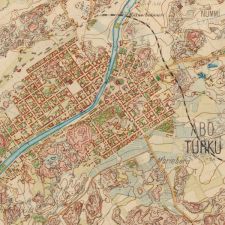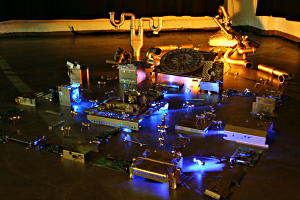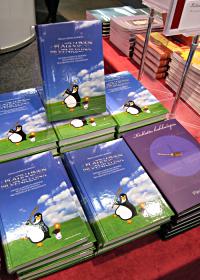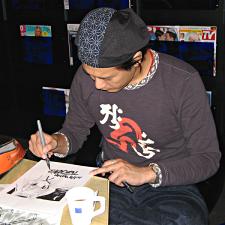Arto's Blog
New job on environmental and cultural data
Posted: 2008-12-03 22:42:23, Categories: General, Work, Finland, Free software, Literature, Politics, 865 words (permalink)
 My
half-time
work experiment felt good enough that I'm doing it again.
Same employer (CSC), 80 hours per
month contract until end of May 2009. This time I'm working on
services providing storage and access to environmental and cultural
data. There are opportunities to study topics I care about and
participate in making design choices, which makes the deal even more
attractive than last time.
My
half-time
work experiment felt good enough that I'm doing it again.
Same employer (CSC), 80 hours per
month contract until end of May 2009. This time I'm working on
services providing storage and access to environmental and cultural
data. There are opportunities to study topics I care about and
participate in making design choices, which makes the deal even more
attractive than last time.
Geographic information wants to be free
A lot of geographic information and data about natural resources is gathered around the world by governmental research institutes. The U.S. has been fairly open with providing access to such data while in Europe most institutes have been sitting on their databases and selling information with very restricted terms. Now the situation is slowly changing, partly due to an OECD recommendation which suggests open access to research data from public funding. The community maintained OpenStreetMap project has challenged closed models, and increasing popularity of partly open privately funded services such as Google Maps plays a role as well. The INSPIRE EU directive (see also the Ministry of Agriculture and Forestry INSPIRE page in Finnish) aims towards interoperability and sharing of geographical data, although its level of required openness falls behind the OECD recommendation.
In Finland, there's a lot of high quality data but it is scattered and little used outside the organizations collecting it. Many voices are raised in support of open access, for example in the Pätevä seminar two weeks ago. In practice progress is rather slow. The public research institutes are pointing towards the Ministry of Finance and the law about fees of public services (Maksuperustelaki) which their funding models are partly based on. Curiously, the key reason for fees in the law is to avoid causing harm to private companies competing in the same domain. However, many sources show (meteorology example) that business overall benefits from freely available public information. A fundamental change of government policy is needed in order to have open access by default also in Finland.
My first task in October was to contribute a little bit to a survey which reviews the current state of geographic information related data in Finland, and gives suggestions on what should be done. The survey focused on what data exists, how to make it available and usable for officials, researchers and politicians, and interoperability issues between different datasets. For example different coordinate systems and semantics are a big hindrance to cross analysis. I personally believe that increased openness will gradually help to improve lower level data compatibility as well. Fully open access raises strong opinions both in favor and against, but there seems to be a more general consensus that at least researchers should have convenient access to data.
(Added a link to the survey on geographic information related data on May 31, 2009)
Preserving cultural data for the next 100 years
Since beginning of November I'm participating in the National digital library project, which is about access, usability and long term preservation of Finnish cultural data. The Finnish National Archives and the National Library are digitizing old books, newspapers and other documents. In this case, open access gladly seems to be the default for at least old works whose copyrights have expired. You can already check out 18th and 19th century newspapers with full text search or municipal documents dating back until Middle Ages. The picture of this blog entry is part of a map of Turku in 1881, retrieved from the National Archives (see the full map). Several Finnish museums are also digitizing their collections. Many new documents, photos, movies and modern art works are already digital when they are created.
Preserving all this material reliably for tens and hundreds of years is a challenging task. The lifetime of computer and storage systems is around five or at most a couple of dozen years. Text in a paper book stays readable for centuries, but digital data will have to be continuously transferred to new, yet unseen storage systems. Current file formats and software to access them will become outdated over time. Human error or attack can have much greater impact in the digital archive than spilling coffee over one book in a physical library.
CSC does not take part in the digitization, but we are currently working on a preliminary requirements specification for the long term storage. Finland is not the first country thinking about it so there's a lot of material available. However, nobody has a complete and definitive solution to the problem yet. There are chances to do pioneering work and contribute to best practices also internationally.
On a personal level, I find projects on environmental and cultural data both very interesting. One challenge is where to focus energy in order to make a difference instead of getting lost between committee meetings and bureaucracy. Another challenge will be to keep work from ruling life, by reserving enough time for hobbies and rest. In November I already surpassed my 80 hours by 50%, not counting when work topics were in my thoughts during free time. However, that's still less than full time and I don't mind working hard if it feels important and rewarding. The half time contract has been a good starting point.
Diving into arts in Helsinki
Posted: 2008-10-31 01:08:50, Categories: Travel, Finland, Hospitality exchange, Helsinki, Literature, Movies, 730 words (permalink)
 When traveling, I'm breathing in a new environment every moment. In
Helsinki, I'm familiar with the surroundings and how the system
works. Part of that is easy access to information what is happening around. As a
result I end up going to more concerts, festivals and other cultural
events than during my travels.
When traveling, I'm breathing in a new environment every moment. In
Helsinki, I'm familiar with the surroundings and how the system
works. Part of that is easy access to information what is happening around. As a
result I end up going to more concerts, festivals and other cultural
events than during my travels.
The most interesting event happened through a CouchSurfing guest. I hosted Kevin who came from Berlin for the Helsinki Festival of New Juggling. The opening show was officially only for festival participants but the organizers kindly let me in with him. That was one and a half hours of most amazing juggling — in a nearby school gymnastics hall. :-) You could really feel the good vibes in the whole crowd. I also went to both public shows attached to the festival. The French group Compagnie Non Nova's Jongleur pas confondre on Saturday was a disappointment, but Ville Walo's and Kalle Hakkarainen's Puun syy was beautiful.
Love and Anarchy film festival took over the screens as usual in late September. The Icelandic comedy Astrópía offered the best laughs and was my favourite this year. Death Note came second by exploring the dark side of human mind in somehow very Japanese way. Some fans of the Death Note manga (comic) didn't appreciate the movie too much though. I should also mention the animation Nausicaä of the Valley of the Wind (Kaze no tani no Naushika) which is one of my favourite movies and comic books from all times. It was in the festival program, but as I had already seen the film and the hour of the screening was bad I skipped it this time.
Last weekend my friend Tuula came in Helsinki and we went together to the yearly book fair. Lectures were the most interesting part of the event. As adventurers and explorers in our own lives we both connected with the theme Vieraat kulttuurit suomalaisin silmin (Foreign cultures through Finnish eyes), and talks about happiness and personal choices in life. Marketta Horn told how she loved meeting people in the lively cheapest classes of trains during her travels in Asia and Australia. – Tän pitäis olla Kela-korvattavia asioita (This should be subsidized by the Finnish social security system), laughed Risto Lindstedt about the therapeutic value of his motorcycle travels. Parliament member and avid cyclist Osmo Soininvaara sitting besides him seemed to agree. – Hulluus tarjoaa helpotusta (Craziness offers relief), suggested Timo Airaksinen in his lecture. – Naisen sydän ei ole yhteensopiva nykymaailman kanssa. Voisiko hän muuttaa maailman sydämellisemmäksi? (The heart of a woman is not compatible with the modern world. Could she change the world into a more heartfelt one?), asked Hilkka Olkinuora, who touched the audience telling how women in particular submit too easily into the busy life expected by the society.
Tuula also joined me on Saturday to Alternative Party, where people come together to celebrate weird computers, music and funky digital arts. This year's event was bigger than ever but it had managed to preserve its friendly atmosphere. Front 242 did a great live concert on Friday night and Brad Templeton from Electronic Frontier Foundation was the guest of honor on Saturday. To my surprise Tuula also found the visit interesting and funny. She was probably more open minded towards the event than me. I realized how I had categorized Altparty as a nerd gathering which others wouldn't understand, and presented it as such.
During October I've also visited the Ateneum Art Museum, the Kiasma Museum of Contemporary Art and the Sinebrychoff Art Museum in Helsinki, plus Museum Centre Vapriikki in Tampere. It was a good reminder that museums are not static: all had plenty of new things to see. I particularly liked the Japanese wood prints in Ateneum and some works playing with light and colors in the Full House exhibition at Kiasma. Hint: Entrance to both Ateneum, Kiasma and Sinebrychoff Art Museum is free of charge on the first Wednesday of every month at 17-20 in the evening.
Settling down after the summer travels has been faster than it was after spending a whole year on the road. I've been meeting with friends, family and relatives, participating in club activities and spending countless hours reading and writing email, as usual. I also have a job again, but will write more about that later.
Books of my homeless friends
Posted: 2007-11-24 16:10:27, Categories: Travel, Work, Free software, Literature, 352 words (permalink)
 A few months ago I wrote about meeting
Päivi and Santeri in Phnom Penh, Cambodia. They describe themselves as
homeless loiterers and claim not to be doing much anything, but they've
turned out to be quite active in writing books. They started
with La Habanera (available in Finnish,
in English
and even in Hebrew)
which tells their story of quitting their jobs and leaving Finland to
escape the rat race. More recently published Platinainen
pilvenreuna (in Finnish) describes Santeri's life as an entrepreneur in more detail
through the rise and fall of Finnish Software Engineering SOT Oy, his
open source software company.
A few months ago I wrote about meeting
Päivi and Santeri in Phnom Penh, Cambodia. They describe themselves as
homeless loiterers and claim not to be doing much anything, but they've
turned out to be quite active in writing books. They started
with La Habanera (available in Finnish,
in English
and even in Hebrew)
which tells their story of quitting their jobs and leaving Finland to
escape the rat race. More recently published Platinainen
pilvenreuna (in Finnish) describes Santeri's life as an entrepreneur in more detail
through the rise and fall of Finnish Software Engineering SOT Oy, his
open source software company.
Platinainen pilvenreuna was particularly interesting for me as during the good days of SOT I was the press secretary of the Finnish Linux User Group FLUG ry, collaborating with Santeri quite often. This is also mentioned in the book. Our relationship obviously changed when he left but friendship stayed. I helped a little with the book by reviewing draft versions of it during spring 2007. It was actually quite fun to read about familiar events in the recent history of information technology in Finland, while relaxing at a bamboo hut by the Indian sea.
Many bits and pieces of information in Platinainen pilvenreuna are in public for the first time. Facts are at least mostly correct. The story is told from Santeri's point of view, which may raise some different opinions on how the more private events actually went — the relations between him and some other main players were rocky at times. The main author of the book is actually Santeri's wife Päivi, which was probably good both for the balance and fluency of the text.
If you'd like to check out the book without buying it, it should be available in some libraries in Finland and I have two copies which I'll be happy to borrow (one of them is out right now). At least I personally liked the book and can therefore recommend it. See also Päivi's and Santeri's other books (in English | in Finnish) and Päivi's blog (in Finnish) about literature, reading and writing.
Kindle and the future of electronic books
Posted: 2007-11-21 01:34:00, Categories: Free software, Literature, 526 words (permalink)
 A couple of days ago, Amazon unveiled their electronic book
reader called Kindle. Newsweek published an extensive story about
it. In short, Kindle is a roughly A5 size, 300 gram electronic
device with a daylight-readable grayscale display and possibility to
buy electronic books from Amazon.com. See also
Gizmodo's hands on test and Wired's
critical comparison between Kindle and Sony Reader for
more information.
A couple of days ago, Amazon unveiled their electronic book
reader called Kindle. Newsweek published an extensive story about
it. In short, Kindle is a roughly A5 size, 300 gram electronic
device with a daylight-readable grayscale display and possibility to
buy electronic books from Amazon.com. See also
Gizmodo's hands on test and Wired's
critical comparison between Kindle and Sony Reader for
more information.
There has been several attempts in the eBook arena before, none of which have been hugely succesful. It's interesting, considering that most other forms of content such as photos, music and videos have already gone digital. Net is used for many kinds of text content such as email and news, but books and magazines are still mainly read on paper.
The most important new feature in Kindle compared to other similar readers is its mobile Internet connection. Transfer fees are included in the price at least in the U.S. That makes it easy to retrieve a new book any time, without the need of connecting the reader to a computer. Compared to PDAs, the biggest difference is the daylight readable screen and longer battery life. Kindle is advertised to survive for up to one week on a single charge, or two days with the wireless connection enabled. That sounds finally enough for not having to care about charging all the time.
Books to the device are delivered in an Amazon proprietary DRM-protected format. Kindle supports some unprotected formats as well, but most of the content will be delivered as protected files. Fortunately it seems that purchased books can at least be backed up to a computer and continued to be read even if Amazon would decide to discontinue the service. However, copying and reading them freely on any device doesn't seem to be possible. It's not a surprise, but still disappointing.
Having a lightweight, daylight-readable, long battery life, Internet connected device for reading books and other information on the web (Kindle provides access to Wikipedia and some kind of limited web browsing) sounds attractive. I'm certainly a potential customer. However, I hate being locked in some proprietary format for the content I buy. Therefore I'm rather unwilling to go shopping for DRM-crippled books; unprotected PDFs would be much better. Similarly, I've already bought plenty of music online in MP3, Ogg Vorbis and FLAC formats, but not a single copy-protected song. Perhaps I could consider if the restrictions are circumvented first — I have bought DVD's after DeCSS came out.
It's early to say whether Kindle will succeed or not. However, with the backing of a company as large as Amazon, which is able to provide a huge selection of available content, it will certainly not be ignored on the market. The majority seem to be less strict about DRM than me, as iTunes taking over a large chunk of music sales has shown. Whether it'll be the now-released Kindle or one of its successors which will become the killer device, I do believe that the real transition from paper to electronic books has now begun.
(The picture in this article is from Wikipedia, taken by user ShakataGaNai, see the picture page for details.)
Geishas, manga and anime
Posted: 2007-09-28 13:59:37, Categories: General, Finland, Hospitality exchange, Japan, Helsinki, Literature, Movies, 786 words (permalink)
 During August and September I again noted how Helsinki is full
of festivals, concerts and other cultural events. I participated in
quite a few, especially in events somehow related to Japan.
During August and September I again noted how Helsinki is full
of festivals, concerts and other cultural events. I participated in
quite a few, especially in events somehow related to Japan.
First there was a performance by three geishas from Kyoto, a promotional event by Finnair and the travel agency Ebookers who are increasing their frequency of flights to various Asian destinations. The traditional dances weren't anything new for me but the geishas also performed a rock, paper and scissors style game designed to entertain sake-drinking customers in the geisha houses. And of course virtually all of my old friends from various Japanese related societies in Finland were there. I compiled a small picture gallery of the event.
My longest trip in August and September was just a cruise to Stockholm, with a Japanese theme organized by the Japania ry society. I wrote a travel story with a few pictures (in Finnish) of the cruise too.
Shortly after the cruise I was asked if I could help the yearly Helsinki Comics Festival by hosting Keitaro Arima, a Japanese manga artist who was one of the main guests of the event. I didn't have to think twice, getting a rare opportunity to spend time with a person from the center of the manga culture (which is very popular in Japan), practising my Japanese and meeting several Finnish comics artists on the way.
It was a very nicely organized festival with a huge variety of interviews, shows and comics from all over the world, naturally emphasizing the Finnish scene. I especially liked that all the evening parties were open for everybody (with the exception of one dinner on Saturday), so one didn't need to be an insider to meet the artists and organizers also outside the daytime program of the festival. Manga fans were certainly happy with Keitaro Arima's signing session — he would not only give his signature but draw an individual picture for every fan in the queue. The session which was originally planned to last for an hour eventually became 3.5 hours.
Arima was staying in a hotel, but in Hospitality Club and CouchSurfing language hosting means offering a place to stay for someone. I've been quite active recently also in that, perhaps even a bit too active. I just counted that 21 people stayed at my place during the last two months. Almost half of them were cyclists and all the continents except Antartica were represented by at least one person. I didn't have a single bad experience and many of the guests were wonderful people, but too many is still too many. I think I'll have a break from hosting now, perhaps not completely closing my door but at least having less guests. It might happen naturally by simply getting less requests, as October and November are not the most popular months to travel in Finland for quite obvious reasons.
The latest chunk of Japanese culture I got in the Love and Anarchy film festival, which faithfully to its traditions featured a good selection of anime and non-animated Japanese films among other good movies from all around the world. I didn't see many movies during my year on the road so now it was a good time to catch up. Especially as the movie theatres in Helsinki are becoming more and more controlled by one single company which shows little else than the latest Hollywood blockbusters.
The animations Paprika and Tekkonkinkreet were both beautiful, although I didn't like the character drawing style in the latter too much. I didn't see yet Tales from Earthsea, the latest offering from Studio Ghibli, but it's one of the exceptions which will come to the mainstream theaters soon. Festival veteran Takashi Miike's this year's flick Like a Dragon was only mildly entertaining, Sakebi's Retribution was better but not exceptional. Same rating for Lost in Beijing by Ping Guo, the only Chinese film I went to see. Korea is producing more and more interesting movies, this year's good picks being Kim Ki Duk's Breath and Chan-Wook Park's I'm a Cyborg but That's Okay, which was a delighfully refreshing take on a difficult topic, my favorite this year. Año Uña was an interesting Brazilian experiment to do a film based on still photos, well done but still not really to my taste. The discussion with the director after the film added a nice personal touch into the viewing experience. Eastern Europe offered some of the darkest but well-done and realistic films this year, with the Cannes Golden Palm winner 4 months, 3 weeks, 2 days directed by Christian Mungiu from Romania and and The Trap by Srdjan Golubovic from Serbia. The Georgian-French joint production 13 Tzameti had the most stylistic black and white shooting.

Copyright Arto Teräs <ajt@iki.fi>, licensed under the Creative Commons Attribution-Share Alike 3.0 Unported License. (Unless otherwise mentioned in individual photos or other content.)